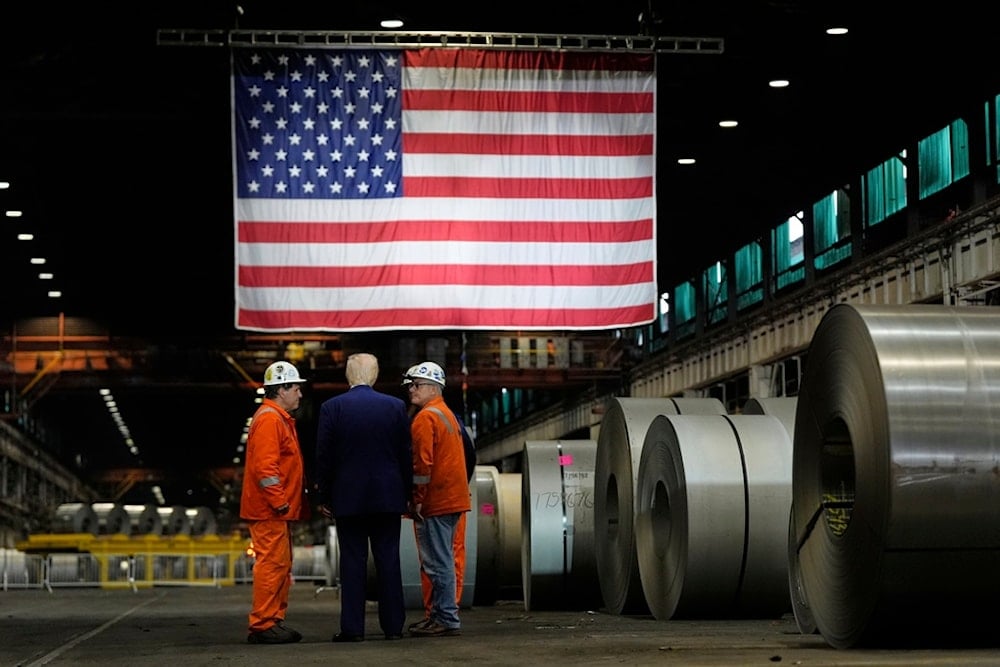Trump-led tariffs, labor strains begin to hit US economy: WSJ
Early indicators show that President Trump's return to aggressive trade and immigration policies is beginning to strain the US economy.
-

FILE - President Donald Trump talks to workers as he tours US Steel Corporation's Mon Valley Works-Irvin plant, Friday, May 30, 2025, in West Mifflin, Pa (AP)
Early signs of economic strain are surfacing as President Trump's aggressive policy agenda begins to take effect, The Wall Street Journal reported on Wednesday. In his first six months back in office, a mix of steep tariffs and hardline immigration measures is starting to weigh on prices and disrupt labor market dynamics.
Although the US economy has so far avoided the recession many economists had warned of, pressure is mounting in less visible but increasingly consequential ways. Inflation climbed to 2.7% in June, roughly in line with forecasts, but key import categories like furniture and clothing experienced noticeable price spikes. According to UBS, core goods prices (excluding autos) saw their fastest monthly increase in three years. "Today's report showed that tariffs are beginning to bite," wrote Omair Sharif, president of Inflation Insights.
The WSJ noted that the temporary resilience seen under Trump's previous trade wars appears to be waning. UBS projects that in the absence of a recession or policy reversal, inflation is unlikely to return to April's 2.3% level before 2027.
Rising input costs and labor market fractures
Industrial input costs have surged since the reimposition of broad tariffs. Steel and aluminum prices are up sharply, and copper hit record highs after Trump's announcement of a 50% tariff on imported supplies, set to take effect August 1. Economists warn that these increases could ripple across sectors, particularly construction, data centers, and semiconductor manufacturing.
Isabella Weber, an economist at the University of Massachusetts Amherst, noted that such tariff certainty can embolden companies to raise prices. "Once this dynamic actually kicks in, it could become self-reinforcing," she said.
The labor market is also flashing warning signs. Employment growth has slowed in industries dependent on undocumented labor, and data from the Labor Department suggest that the foreign-born workforce has declined significantly since March. ADP reported the first monthly drop in private-sector jobs since early 2023, and job participation rates among immigrants have fallen. Equitable Growth researchers project that continued trade-cost uncertainty could raise unemployment by more than 0.6 percentage point by 2028.
Read more: 'Heart attack' expected for US economy in 3 years amid growing debt
Superficial stability, underlying inequality
Despite growing concerns, topline indicators remain strong. US banks, including JPMorgan, posted better-than-expected earnings this week, and consumer spending has not collapsed. "We continue to struggle to see signs of weakness in our customers," JPMorgan CFO Jeremy Barnum said. "The consumer basically seems to be fine."
Yet, this resilience masks a more uneven economic fallout. Lower-income households have begun to pull back, with banks and credit-card issuers reporting weaker spending in that segment. Bond markets, too, are reacting: the 30-year Treasury yield rose above 5% for the first time since May, reflecting investor unease.
According to the Yale Budget Lab, the long-term cost of the current tariff regime could reduce average household income by as much as $2,800 annually. Other studies suggest that these policies may slow GDP growth by up to 0.9 percentage points and lead to over 600,000 fewer jobs in the medium term.
Mixed signals from Fed and White House
The Trump administration continues to minimize the risks. After Tuesday's inflation data, Trump posted on social media that inflation was "very low" and again urged the Federal Reserve to slash interest rates. But Fed officials appear more cautious. While Boston Fed President Susan Collins acknowledged that tariff effects may be "modest", other analysts worry that the current combination of rising prices and labor softening presents a challenge for monetary policy.
Former Fed economists warn that the central bank is facing a rare dilemma: tariff-driven inflation is heating up just as the labor market begins to show strain.

 4 Min Read
4 Min Read








